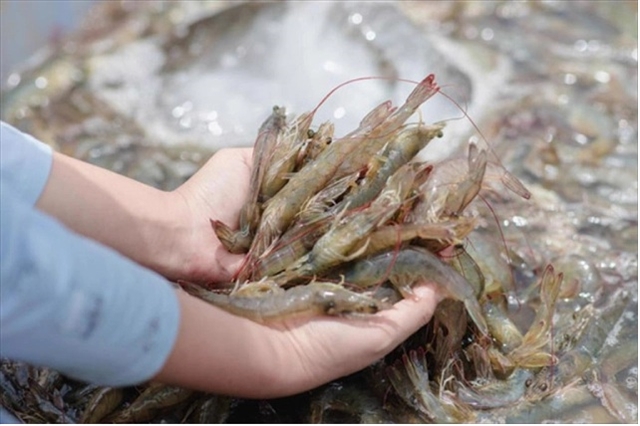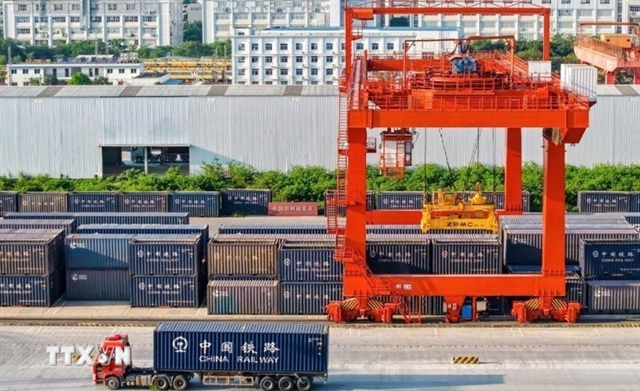.jpg) Economy
Economy

 |
| In the beginning of June, shrimp selling prices plummeted by about 40 per cent compared to April. — Photo vasep.com.vn |
HÀ NỘI — The shrimp industry needs a general solution from the production of shrimp seeds to the processing stage to achieve this year's shrimp export target.
In the beginning of June, shrimp selling prices plummeted by about 40 per cent compared to April. Meanwhile, the cost of shrimp seed and feed increased. Those factors have caused shrimp farmers in the Mekong Delta to suffer heavy losses.
In the farming ponds of farmers in the coastal provinces of Tiền Giang, Trà Vinh, Bến Tre, Sóc Trăng, Bạc Liêu, Cà Mau and Kiên Giang, the selling price of shrimp fell from VNĐ150,000 per kilo in April to VNĐ95,000 in the beginning of June. The price of white-leg shrimp is now at VNĐ65,000-75,000 per kilo, down 38 per cent compared to two months ago.
According to the Association of Seafood Exporters and Producers (VASEP), the decline in selling prices of raw shrimp is due to the plunge in exports. Export orders in the shrimp industry have decreased by 20-50 per cent and inventories have increased. Those factors have forced shrimp processing enterprises to reduce the purchase of raw shrimp.
Shrimp exports in the first five months of 2023 only reached US$1.22 billion, down 34.4 per cent over the same period last year. The purchasing power of shrimp in the two main markets, the EU and the US, fell sharply due to high inflation. China reopened from January, but the shrimp exports to this market still decreased by 40 per cent compared to the same period in 2022.
Localities with large shrimp farming areas, such as Cà Mau, Bạc Liêu and Sóc Trăng, have recently seen many factors to make farmers not re-farm shrimp, including the decrease of the shrimp selling prices, prolonged unfavourable weather conditions, diseases in shrimp farms and high production costs.
Võ Quan Huy, chairman of Mỹ Thạnh Shrimp Association in Sóc Trăng, told nhadautu.vn that shrimp farmers are currently facing difficulties because input costs, especially the price of shrimp feed, have increased very quickly, but the selling prices of raw shrimp have fallen. That situation has caused farmers to have losses and lack capital to farm shrimp again.
Võ Văn Phúc, general director of Vietnam Organic Seafood Joint Stock Company, said that while the selling price of shrimp is falling sharply, input costs such as the price of feed, seed and other materials have continuously increased to VNĐ70,000-100,000 per kilo. Transport costs are also high due to poor infrastructure.
According to Huy, to remove the difficulties for the shrimp industry, besides the efforts of shrimp farmers, the State needs to have supportive measures in technology application and digital transformation, and increase credit capital for re-production.
There are many establishments supplying shrimp seed, but the quality is not uniform. Therefore, management agencies need to develop standards for shrimp seed suppliers and the suppliers must provide transparent information on the quality of seed, Huy said.
Hồ Quốc Lực, chairman of Sao Ta Food Joint Stock Company and former VASEP chairman, said that the most difficult thing in the shrimp industry now is the low selling price and the high production cost of shrimp.
Enterprises now must reduce costs, improve processing levels, diversify products, increase product quality and seek new markets.
Large-scale shrimp farming areas supply only about 10 per cent of the total annual shrimp production, while 90 per cent of total production is supplied by household farmers with small-scale production. Therefore, farmers need support in terms of capital, infrastructure, seed and market information, Lực said.
He also said that stopping the production of seed due to the losses of shrimp farmers will create negative impacts in the shrimp industry's supply chain.
Nguyễn Văn Trường, chairman and general director of Cafatex Seafood Export Joint Stock Company, said this situation may lead to processing factories lacking raw materials when Việt Nam's seafood export market recovers.
The General Department of Fisheries under the Ministry of Agriculture and Rural Development said that to achieve the target of shrimp export turnover of $4.3 billion in 2023, the agricultural sector has set a target of cultivating about 750,000 hectares of brackish water shrimp with an output of more than one million tonnes. However, the progress of stocking shrimp has been slower than planned due to market difficulties and unpredictable shrimp prices.
To promote shrimp exports by year end, it is necessary to have measures to stabilise the input prices for shrimp farming, according to experts.
In addition, it is necessary to promulgate mechanisms and policies, especially on capital support, to form regions producing raw materials for processing shrimp feed, which would reduce dependence on imported raw materials.
According to Kim Thu, VASEP's shrimp market expert, the US is still the largest importer of Vietnamese shrimp. Meanwhile, Japan surpassed China to reach the second position with nearly $150 million of Vietnamese shrimp import value in the first four months of the year, followed by China and South Korea importing over $100 million of Vietnamese shrimp each.
Northwest European countries also increased their demand for shrimp imports. To stand firm in the European market, shrimp enterprises need to meet its strict requirements on food safety. The EU is Việt Nam's fourth largest shrimp importer, accounting for about 14 per cent.
Shrimp is Việt Nam's main export seafood product with annual export turnover accounting for over 40 per cent of the national total seafood export turnover. Việt Nam has exported shrimp to 100 countries, including the five largest markets of the US, Japan, China, the EU and South Korea. — VNS


.jpg)

